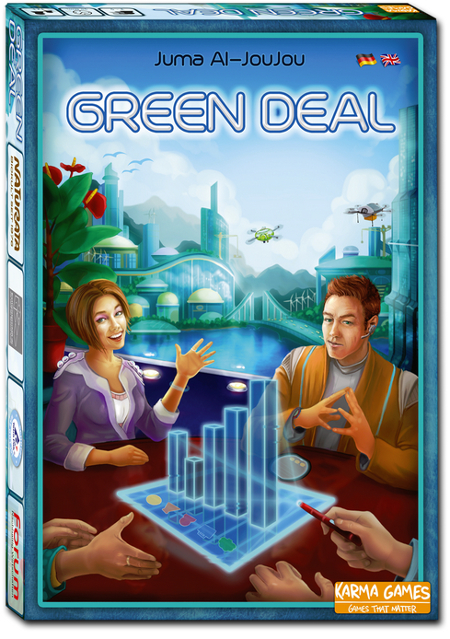
The Basics:
- For ages 10 and up
- For 3 to 5 players
- Approximately 90 minutes to complete
Geek Skills:
- Counting & Math
- Logical & Critical Decision Making
- Reading
- Pattern/Color Matching
- Strategy & Tactics
- Hand/Resource Management
- Auctioning & Bidding
- Worker Placement & Area Control
Learning Curve:
- Child – Easy
- Adult – Easy
Theme & Narrative:
- Make your company profitable while avoiding PR pitfalls
Endorsements:
- Gamer Geek approved!
- Parent Geek approved!
- Child Geek mixed!
Overview
American political satirist, Stephen Colbert, said “Facts matter not at all. Perception is everything. It’s certainty.” This strongly suggests that obtainable and measurable factual information can be trumped by a well constructed PR campaign. Which, sadly, we know to be true. In this game, how your company is perceived by the world is very important to you and your stockholders as you attempt to cut costs, reduce overhead, neglect to follow some laws, and do all you can (within reason) to be profitable.
Green Deal, designed by Juma Al-JouJou and published by Karma Games, is comprised of 1 game board, 15 “Social” Sustainability tiles, 15 “Jobs” Sustainability tiles, 15 “Environment” Sustainability tiles, 15 “Research” Sustainability tiles, 15 “Social” Sustainability cards, 15 “Jobs” Sustainability cards, 15 “Environment” Sustainability cards, 15 “Research” Sustainability cards, 30 Action cards, 1 PR Points card, 9 Loan cards, 5 Auction wheels, 5 Information cards, 5 PR Assessment cards, 90 Player markers (in 5 different colors, 18 per player), 1 Round marker, and 9 PR chips (in the values of 1 through 3). All the game components are solid and durable. Some assembly is required by the game’s owner. The 5 Auction wheels must be built and 1 small sticker needs to be placed on 1 Player marker for each player.
Game Set Up
To set up the game, first place the game board in the middle of the playing area. Make sure all the players can reach it from their sitting positions.
Second, have each player select a color and give them the matching Player markers. Place any Player markers not used back in the game box.
Third, each player places 1 Player marker on the “20” value space on the game board’s Cash Scale track and give each player 1 Auction wheel, 1 Information card, and 1 PR Assessment card.
Fourth, each player places 1 Player marker on the “0” value space on the game board’s perimeter Victory Point track and 1 Player marker on the Income Scale track. The value on the Income Scale track will be determined by the number of players in the game.
Fifth, each player places 1 Player marker on the “0” value space on the game board’s “Environment”, “Jobs”, “Social”, and “Research” Sustainability Scale tracks.
Sixth, separate the Sustainability cards by type and shuffle each to create 4 different decks. One side of the card is in English and the other is in German. The only difference between the two sides is the text. Icons, images, and number values are identical.
Seventh, take the Action deck, shuffle, and split in half. To one side of the game playing area, place the following card and decks in the order listed here from left to right (all cards are placed face-up): PR Points card, “Environment” Sustainability deck, “Jobs” Sustainability deck, “Social” Sustainability deck, “Research” Sustainability deck, “Tax Refund” Action card, Action card deck #1, Action card deck #2, and the Loans deck.
Eighth, and bear with me here as this is a bit goofy, shift the Sustainable and Action decks upwards and then draw the top cards of each deck, placing this card below the decks (in the space the decks recently occupied). The lower row of cards represent the cards that are available and the decks above with the top-most visible cards represent the cards to come.
Finally, the Player marker with the sticker is placed in front of the player and the Round marker is placed on the “1” value space on the game board’s Round track. Place all the remaining game components to one side and within easy reach of at least 1 player.
That’s it for game set up. Time to wheel, deal, and spin.
The Not So Subtle Art of Public Relations
Green Deal is played is rounds for a total of 10 rounds in a single game. Each round contains 4 distinct phases. A single round of game play is summarized here.
Note: The game’s rule book goes into great detail about specifics that I am not covering here. There are a number of game conditions that depend on the number of players and the actions taken by individual players that will influence the game. Refer to the rule book for specifics.
Phase 1: Auction
During this phase, each player takes their Auction wheel and selects a value using the pointer, making sure to keep the value hidden from opponents. Once everyone has selected a value, the Auction wheels are revealed simultaneously.
When bidding, a player cannot bid a value that exceeds their current total amount of cash. Each player’s total cash worth is tracked on the Cash Scale track. This allows a player’s opponent’s to easily know what their maximum is, but they have no idea where in the range of “0 to maximum” the player might decide to bid.
Based on the bid amount values, the turn order is now determined with the player bidding the highest placing their Player marker in the “1” value space of the Round Order track found on the game board. Then the player with the second highest does the same and so on until all the players have placed their Player marker. Ties are broken by least cash on hand.
Phase 2: Accounting
Time to exchange corporate assets.
First, players move their Player markers on the Cash Scale track to a new space. The new space is equal to the current space value minus the bid value on the Auction wheel. For example, if the player was on the “20” value space on the Cash Scale track and they bid “5” on the Auction wheel, they would move their Player marker to the “15” value space on the Cash Scale track.
Second, each player then adjust’s their Player marker’s value on the Cash Scale track based on the Player marker’s space value on the Income Scale track found on the game board. Players can only collect income during this phase of the game. They cannot adjust their income value on the track at this time.
Phase 3: Investment
After paying your bills and receiving income from previous investments, it’s time to improve your company’s portfolio. A player may perform any of the following in any order they like during this phase of the game.
Purchase 1 PR Chip
PR chips come in values “1”, “2” and “3”. The PR Points card shows how much each PR chip costs the player. The cost reduces the player’s Cash Scale value. Only 1 PR chip can be purchase per player per round. When purchased, PR chips are placed in front of the player for later use.

Pay Dividends
A player can, once per round exchange cash for victory points. The Income Scale track indicates the total value of the exchange, but the payment must come from the Cash Scale track (i.e. you cannot sell investments).
Play Action Cards
If the player previously purchased Action cards that can be used during this phase, they can elect to take those actions where applicable.
Pay Off Loan
If the player can, they may elect to payoff the Loan card they took in a previous round by reducing their Cash Scale track value. However, doing so does not allow a player to take a new loan during the same round they pay off a previous loan. Not a bad thing, but it is limiting. A player may, if they so choose, pay off multiple loans during a single round. Any Loan cards that are paid off are placed at the bottom of the Loan draw deck.
A player must also select 1 action out of a possible total of 4. Each action is summarized here in no particular order of importance. When purchasing cards, only those on the bottom row are available.
Buy 1 Sustainability Card
The player has 4 to choose from. Each card represents a specific area of interest to the world community. Specifically, the environment, jobs, social concerns, and research. Each card represents a project that will cost the player money and time to complete, but will also provide income (maybe) and victory points (a certainty). When a player takes a Sustainability card, they must be able to pay for it by reducing their Cash Scale and Income Scale track value and not going below “zero”. Then they adjust their income by reducing or increasing it per the card’s information, and then move their Player marker along the Victory Point track a number of spaces equal to the value shown on the card. Finally, the Project Size value on the Sustainability card indicates how many spaces the player’s marker should be moved upwards on the matching Sustainability scale. When done, the player places the Sustainability card in front of them.
Let’s look at an example Sustainability card. Each value tells the player how to move their Player markers. Using this information, a player can determine if investing in the project is going to improve their company’s standing.

Buy 1 Action Card or Tax Refund Card
Action cards provide the player a unique condition, effect, or additional action that is not otherwise available to the players in the game. As such, they are potential game changers and powerful. But such power comes at a cost. Like Sustainability card, Action cards must be purchased. When the Action card can be used depends on the icons listed on the card.
- No Hand Card Icon: The Action card is immediately activated upon purchase.
- White Card Icon: Action card can be activated during the Investment phase of the game.
- Horizontal Eight (Infinity) Icon: Once the Action card is triggered, the effects last until the end of the game.
- Victory Points: Action card can only be played at the end of the game during the specified evaluation period.
Action cards not yet played are kept in the player’s hand. Action cards that are played and cannot be activated again, are set in front of the player.
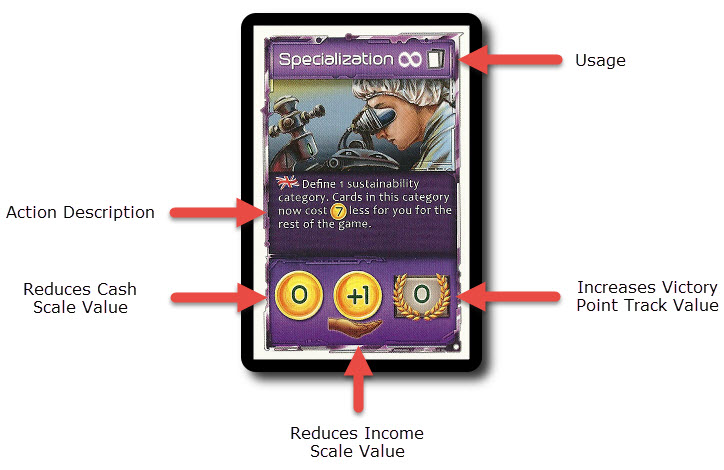
Or, if the player prefers, they can go for a tax refund. The Tax Refund card is a sub-type of Action card, although it is treated as a unique card. And with good reason. The Tax Refund card is available to all players and can be used by all players in a round, as it is not “claimed” by an individual player. If the player selects this card, they can either increase their PR by +1 or move their Cash Scale value by +4. Sounds powerful, and it is, but it also eats a turn.
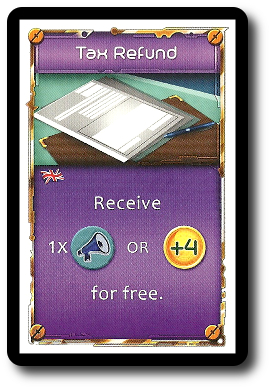
Take 1 Loan Card
A Loan card provides the player with a cash injection, giving them purchasing power as a result. However, loans must be repaid. If they are not paid off by the 10th round, loans penalize a player 2 victory points per 1 cash value not repaid. Unlike the Sustainability and Action cards, the only Loan card available to the player is the top-most card in the deck. A player can have a maximum of 3 Loan cards per game. There are different loans with different values, so players should keep their eye out for one that is a good deal. Desperation, however, often trumps patience.
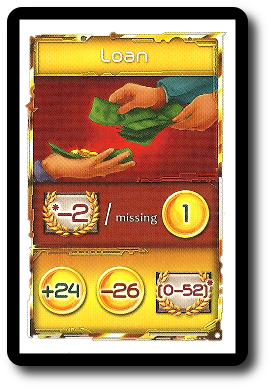
Take 1 Action Card or Tax Refund Card AND 1 Loan Card
The player can select 1 Action card or the Tax Refund card. After doing so, they can also take the top-most Loan card. A one-two financial punch if timed correctly.
Phase 4: Expansion
The Sustainability tiles are now collected by those who purchased a Sustainability card during the round. Each Sustainability tile contains a value “1” through “5”, which is meant to represent the same number of spaces the Player marker move up the Sustainability Scale track. The exact value and color must match the Sustainability card purchased. Once collected, the tile is placed on the map section of the game board along with a Player marker. The first such tile must be placed in designated starting position. After that, all subsequent tiles must be placed next to an existing tile owned by the player either vertically, horizontally, or diagonally. Visually, the placement of tiles on the map represents the global influence the player’s company has.
Placing a same colored tile to an opponent’s tile that is the same color indicates that a level of cooperation or competition must take place. At its core, this is player versus player, but the outcome can be beneficial if the players like. Or, if they don’t like, the outcome can be very negative for one of the players.
- Cooperation: If adjacent tiles are of horizontally or vertically adjacent, as well as being the same color (same Sustainability type), the both players can profit of each others research and development. The Player markers on the Income Scale track increase a total number of spaces as the average between both tile values (rounded down). Cooperation can also occur with a player’s own tiles or with multiple tiles multiple times. For example, a tile of with a project value of “3” and an adjacent tile with a project value of “5” would equal “8”. The average would be “4”. Owners of both tiles would increase their Income Scale track Player marker by +4.
- Competition: Competition is the opposite of Cooperation, wherein a player harms another instead of seeking a mutually beneficial joining of resources. The higher tile will be attacking the adjacent lower valued tile. Both tiles must belong to the same Sustainability category, as well. The difference is determined between the two tiles. The income of the owner of the higher tile increases by the calculated difference, and the owner of the lower tile decreases their income by the calculated difference. The calculated difference can never cause one player to go below zero.
Phase 5: Set Up for Next Round
After phase 4 is complete, it’s time to set up for the next round of game play.
- All Sustainability and Action cards not purchased are discarded (remember: this is the bottom row of cards).
- Draw new Sustainability and Action cards.
This completes a single round of game play. Unless a company assessment is required (as indicated on the Round track), the next round of game play now beings. Move the Round marker to the next highest number value and being the next round of game play with phase 1 noted above.
PR Assessment
What a company does within its own offices is not actually its own business. The media, government, and the general populace want to know what the player’s company is doing to be a good steward of Mother Earth. This can be potentially embarrassing, if not fully damaging, to a company. However, a company can spin what it has been doing to make itself and its actions seem a lot more positive than what it really is. This is where a player’s ability to use PR comes into play.
Over the course of the game (rounds 4, 7, and 10), each player’s company will be evaluated. Evaluations occurs during the 10 rounds of game play and then again after the 10th round is completed. Since each evaluation (represented with a symbol that looks like a handheld megaphone) is shown on the Round track, players can adjust their strategy to play to each evaluation to maximize possible benefits. These evaluation periods are referred to as “PR Assessments”.
During an assessment, each player takes their PR Assessment card and secretly places any PR chips they might have on the 4 Sustainability types. If a player wants to, they can save a maximum of 1 PR chip for later by placing in it in the “1x” circle space in the middle of the card. After PR chips are placed, all PR Assessment cards are revealed.
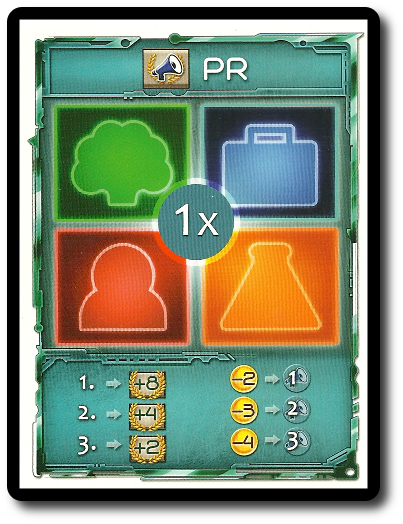
Each of the 4 Sustainability types are now assessed. This is where the Player marker with the sticker comes into play. This Player marker is used to indicates the player’s temporary position on the Sustainability Scale tracks. Values during assessments can fluctuate, putting the player’s Sustainability score well above what the scale records.
The scores are provided as follows:
- The player with best PR image (highest PR value) is awarded 8 victory points
- The player with the second best PR image is awarded 4 victory points
- the player with the third best PR image is awarded 2 victory points
There are two important things to note here.
- A player’s Sustainability Scale value does not actually change during the assessment. The Player marker without the sticker stays in place.
- Any benefits derived from a high PR value are short-lived. They are calculated during the assessment period and are then no longer used. Any PR chips used during the assessment are returned to the PR chip pool.
Sustainability Assessment
Public relations are not the only thing a player’s company needs to be aware of. There are also detailed Sustainability reports that are independently collected and published. During rounds 6 and 10, inspectors review a player’s company to determine if they are using a model that allows for a certain level of sustainability. It should be noted that these report as specifically designed to find faults in companies, not champion initiatives that promote sustainability.
In game terms, this means players get points for their lowest Sustainability Scale track value. PR chips cannot be used here and players should carefully consider all of their Sustainability Scale values to maximize their total points.
Company Evaluation
After a player’s company has been hammered by the Press during the PR Assessment and ridiculed by third-party evaluators, the investors have some questions. Investors want a return in their investment and are only willing to give their money to a company that will return profits.
- The player with the highest Income Scale track value earns 12 victory points
- The player with the second highest Income Scale track value earns 8 victory points
- The player with the third highest Income Scale track value earns 4 victory points
If two or more companies share the same income value, the investors are willing to invest in all of them equally.
Ending the Game
The game continues until the end of the 10th round. All the assessment and evaluations take place for the final time in the following order.
- Players earn victory points for their purchased Action cards (where applicable)
- Sustainability assessment
- Company evaluation
- PR assessment
- Reduce points for any Loan cards that cannot be paid off
After all the victory points have been calculated, the player with the most victory points wins the game.
Game Variants
PR Simplification
The game can be simplified (somewhat) by removing a number of victory conditions. Specifically, players cannot win the game through paying dividends, Action cards, PR assessment, Sustainability assessment, and Company Valuation. This leaves the only way to win through Sustainability cards. This works very well with younger players and non-gamers.
To learn more about Green Deal, visit the game’s web page.
Final Word
The Child Geeks were mixed when it came to the game’s approval. The split occurred at two important points revolving around game play. The first was the auction. All of the Child Geeks understood that they could not spend more than what they had, but not all the Child Geeks understood the value of the auction. According to one Child Geek, “There is no way I am going to spend my money just to be first.” This way of thinking, however, reduced the player’s ability to purchase the cards they wanted. One Child Geek said, “You are not spending your money to be first. Your spending your money to make sure you have as many choices as possible.” Yes! Exactly! The other point of division was purchasing cards in general. Some of the Child Geeks disliked how purchasing a card not only had the short-term effect of reducing cash, but also the long-term effect of impacting income, as well. One Child Geek said, “I don’t like that I have to pay for a card and then permanently lose money, too. That’s like saying I have to pay an arm and a leg and then taking the arm and leg!” But this was also seen as perfectly reasonable by other Child Geeks. An older Child Geek said, “It makes total sense that I would invest in a project and it would reduce my company’s total earnings over 10 rounds. I don’t think it’s that far-fetched.” No, it certainly is not. When all the games were over, the Child Geeks were split evenly down the middle. It all came down to game mechanics, as all the Child Geeks agreed that the game was an interesting one. What they couldn’t agree on was if Green Deal was a good deal or not.

Our first game, which we botched pretty badly due to a rules misunderstanding, but was nonetheless entertaining
The Parent Geeks had a great time with Green Deal. According to one Parent Geek, “This game is not at all what it appears to be at first. The first round was a real surprise. The second round was even a bigger surprise. I love how everything builds on top of each other.” The Parent Geeks liked how the Sustainability cards were used to build a strategy and the Action cards provided tactics. One Parent Geek said, “Oh, I really like how I can spend a round planning to purchase an Action card that gives me just the right advantage I need to get a head in the next round.” The only aspect of the game the Parent Geeks didn’t care for was the Auction wheel, which we later discovered had an easy fix. Other than that, no complaints whatsoever. In fact, all the Parent Geeks voted to approve Green Deal without a second thought.
The Gamer Geeks, not surprisingly, dived as deep as they could into the game. When they finally resurfaced, they wore big grins of satisfaction. One Gamer Geek said, “Excellent game. Not much to look at and the rule book is not that great, but the game is excellent.” Another Gamer Geek said, “The game gives its players a lot of room to maneuver. Climbing the Sustainability Scale, dominating the map, hostile takeovers, and using actions is just the tip of the iceberg. There’s the assessments, the management of funds, and maneuvering yourself each round for best position on a global scale. It’s a lot to think about, but the game presents it all in a very elegant way.” Like the Parent Geeks, the Gamer Geeks were disgusted by the Auction wheel, but stopped short of letting their dislike of the faulty game component ruin their game. After all the games were over, the Gamer Geeks were satisfied. They fully endorsed Green Deal, finding it to be a game that challenged and entertained them on multiple levels.
Here’s a word of advice. Avoid the Loan cards. They are like giant pieces of delicious candy, tempting you to take them. They have a sweet siren song that is very hard to avoid, but do so if you can. Which is not to say they are not useful. I take them often. The Loan cards are just one more item to manage in a player’s company. They can inject some much-needed cash, but their benefits are not long-term and each loan must be paid off or the player suffers a penalty. That’s pretty cool and acts just like a real loan. It’s this level or realism and impact to the player’s final score that makes loans easy to understand and potentially very tempting. Especially when we live in a society where we “buy something now” but “pay for it later”.
One more final word of advice, which is actually more of a warning. The rule book provided in the game is not accurate. The “almost complete” rule book was sent to the printer and is included with all the games. Throw it away. A PDF of the updated and fully complete rule book is available for free. Even with the updated rule book, the game is not immediately easy to understand. The layout is a bit confusing at first, to say the least. I suggest you set up the game and read the rules with the game in front of you. I guarantee it will make sense a lot faster if you do.
Green Deal is a long game at first. Ten rounds of game play can take up 2 hours or slightly more with new and inexperienced players. However, the game is very tasked-based and somewhat linear, meaning each round is a duplicate of the last, with few exceptions. Once a player understands the basics, the only real decision making is what cards to purchase. Towards the end of every game, each round was moving faster than the previous one. Each new game with a group of players who were familiar with the rules always moved at a brisk pace.
A quick word on the Auction wheels. Yes, they are spinners which is problematic. Especially when we consider that the Auction wheel is meant to record and hold the value the player selected. If you put the Auction wheel together, the pointer moves freely as you would expect a pointer to move on a spinner. This caused a number of our players some grief and generated negativity towards the game. A simple fix, however, can address the game bits unfortunate design. By pushing the pointer down, you place it closer to the cardboard. This generates friction, resulting in a pointer that stays where it should. Admittedly, this is an unnecessary and eye-rolling hack, but one that is worth mentioning because it works.
Apparently, I and everyone else thought that Green Deal was going to be a game about the evils of the world and how only environmentally conscious activity and activism can save the human race. But this is not he case. Green Deal is about outward perception that may or may not be accurate while at the same time pursuing a company’s goals of global expansion. A player can certainly run their company as green as they like, but it isn’t necessary. A player can make up for any lack of good environmental stewardship through powerful PR campaigns or focusing in other areas of sustainability that might offset less than savory behavior.
I had a lot of fun with Green Deal. You are playing 2 games at once: the short game and the long game. Each round offers the player an opportunity to pursue their own agenda and set themselves up for points in the next or current round. In the long-term, the player knows where they need to be at to earn victory points, but to what degree greatly depends on what they do during the individual rounds. This constant thinking in the present and the future to come was challenging, rewarding, and entertaining.
Visually, Green Deal isn’t that interesting. It’s a big board of stuff to move around. Game play wise, it’s wonderful. I’ll stop just short of saying “brilliant” as the game is not breaking any new ground. It’s design and game play is very well done resulting in a smooth game playing experience full of strategy, tactical decisions, and engrossing depth of play. In my opinion, Green Deal is an outstanding game. While Green Deal is not Father Geek approved, I highly encourage you to sit down and play the game and try it for yourself. For the Child Geeks, it’s going to fall a bit flat. For everyone else, it’s going to be a lot of fun.
This game was given to Father Geek as a review copy. Father Geek was not paid, bribed, wined, dined, or threatened in vain hopes of influencing this review. Such is the statuesque and legendary integrity of Father Geek.




The auction wheel “problem” can easily be fixed like this:
http://boardgamegeek.com/image/2354224/green-deal